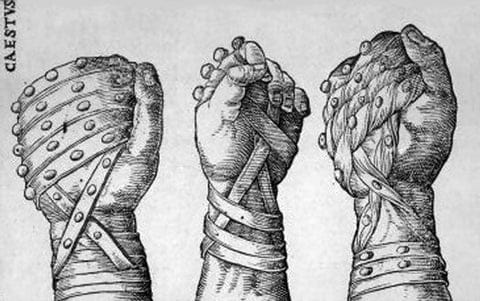Imagine a small, yet formidable weapon that fits perfectly in the palm of your hand, capable of turning a simple punch into a bone-crushing blow. That’s a knuckle duster! Join us as we delve into the fascinating and often brutal history of these controversial objects, tracing their journey from ancient battlefields to the streets of the modern world. We’ll explore their origins, their evolution, and the legal complexities that surround them. Get ready to uncover the intriguing stories behind knuckle dusters, answering questions like, “What do people in the US call knuckle dusters?” “Are brass knuckles really that effective?” and “Were they actually used in World War II?”
History of Knuckle Dusters
Knuckle dusters – those simple yet brutal weapons – have a history almost as old as fighting itself. Long before guns and even swords became commonplace, early civilizations sought ways to enhance their punches in combat.
Ancient Origins:
The earliest forms of knuckle dusters can be traced back to ancient Rome. Gladiators, those legendary warriors, used a weapon called a “cestus,” a leather hand covering reinforced with metal studs. These early knuckle dusters were designed to inflict maximum damage, turning a fist into a lethal weapon. Similar weapons were also used in other parts of the world, including India and the Sikh Kingdom, suggesting a universal desire to gain an advantage in hand-to-hand combat.
The 19th Century and Beyond:
By the 19th century, knuckle dusters, often made of brass or iron, had become a popular tool for self-defense among civilians and soldiers alike. During the American Civil War, soldiers, particularly those engaged in brutal, close-quarters combat, would craft their own knuckle dusters from materials like wood or even melted-down lead bullets.
As technology progressed, so did the knuckle duster. In the late 19th century, the infamous “Apache revolver” emerged, a horrifying combination of a gun and a built-in knuckle duster, showcasing a chilling ingenuity in weapon design. Around the same time, “knuckle knives” also appeared, integrating blades into the knuckle duster design.
Les Apaches and the Criminal Underworld:
The history of knuckle dusters is intertwined with crime and violence. In late 19th century Paris, a notorious gang known as “Les Apaches” adopted knuckle dusters as their weapon of choice. They saw themselves as urban warriors, and for them, knuckle dusters were not just weapons but symbols of power, intimidation, and rebellion against authority.
Modern Times:
While the basic design of the knuckle duster has remained remarkably consistent over time, new materials and innovations have led to variations, including specialized versions for military and law enforcement use. However, due to their potential for lethality, knuckle dusters have faced increasing legal restrictions throughout the 20th and 21st centuries.
Where did Knuckle Dusters Originate?
While pinpointing the precise origin of knuckle dusters is difficult, historical evidence suggests they have a long and global history.
Ancient Precursors:
- Ancient Rome (circa 1st Century AD): Roman gladiators used the “cestus,” a leather hand-wrap studded with metal, to amplify their punches.
- India (Ancient Period): The “Vajra-mushti,” a similar weapon made of metal and designed to fit over the knuckles, was used by warriors in India.
- Sikh Kingdom (1500s-1800s): Sikh warriors utilized a weapon called the “Sher Panja,” a steel claw-like weapon worn over the hand, resembling a more elaborate knuckle duster.
These examples illustrate that the concept of enhancing the fist for combat has existed across different cultures and time periods.
The Modern Knuckle Duster:
The knuckle duster as we know it today, with its distinctive finger holes and compact design, likely emerged in the 1800s. Its popularity surged during this time due to several factors:
- Rising Urban Crime: As cities grew, so did concerns about personal safety. Knuckle dusters offered a discreet and potent means of self-defense.
- Military Conflicts: The American Civil War (1861-1865) saw widespread use of knuckle dusters by soldiers on both sides of the conflict.
- Material Availability: The Industrial Revolution made it easier and cheaper to produce knuckle dusters from metals like brass and iron.
Why Are Knuckle Dusters Illegal?
Knuckle dusters are illegal in many parts of the world, including many states in the US and countries like the UK. The reasons for their illegality are rooted in their inherent dangerousness and potential for causing serious harm.
Force Multipliers:
Knuckle dusters act as force multipliers for punches. By adding weight and concentrating the force of a blow onto a smaller surface area, they can significantly increase the damage inflicted. Even a relatively weak punch with a knuckle duster can cause severe bruising, lacerations, bone fractures, and even death.
Intent as Weapons:
Unlike some tools with multiple uses, knuckle dusters are primarily designed for combat and have limited practical applications beyond fighting. This makes it difficult to argue that they are intended for anything other than causing harm, which contributes to their classification as illegal weapons in many jurisdictions.
Historical Association with Violence:
The long history of knuckle dusters is intertwined with violence, crime, and gang activity. Their association with notorious groups like “Les Apaches” in Paris reinforces the perception that they are tools of aggression and brutality.
Legal Restrictions:
- United Kingdom: The Offensive Weapons Act of 2019 makes it illegal to possess, sell, or manufacture knuckle dusters in the UK.
- United States: Laws regarding knuckle dusters vary by state. Some states have outright bans, while others regulate them more leniently or require permits for possession.
The legal landscape surrounding knuckle dusters is complex and constantly evolving, highlighting the ongoing debate about the balance between personal safety and public safety.
What year did brass knuckles become illegal?
There’s no single year when brass knuckles became illegal across the board. Instead, laws banning or restricting them have been enacted gradually over time and vary widely by location.
Early 20th Century:
The move to outlaw brass knuckles gained momentum in the early 20th century as concerns grew about their use in violent crimes. Many cities and states in the US began enacting their own regulations, often classifying brass knuckles as “concealed weapons” or “dangerous instruments.”
No Federal Ban in the US:
Interestingly, there is no federal law in the United States that outright bans brass knuckles. However, federal laws like the Gun-Free School Zones Act of 1990 prohibit them on school grounds. Additionally, federal agencies like the Transportation Security Administration (TSA) prohibit brass knuckles on airplanes.
Ongoing Legal Changes:
The legal status of brass knuckles continues to be debated and redefined. Some states have recently moved to ease restrictions, while others have maintained or strengthened bans. It’s crucial to consult current local laws before possessing or using brass knuckles.
What do Americans call knuckle dusters?
In the United States, the most common term for knuckle dusters is “brass knuckles.” This term has persisted even though modern knuckle dusters are made from various materials, including steel, aluminum, and even plastic. The historical association with brass likely stems from their prevalence during the 19th century, when brass was a readily available and affordable metal for manufacturing.
In what states are brass knuckles illegal?
As of 2023, the legality of brass knuckles in the United States remains a patchwork of state and local laws. Here’s a general overview:
States Where Brass Knuckles are Illegal:
Approximately 21 states have laws that explicitly outlaw brass knuckles. These states generally consider them dangerous weapons and prohibit their possession, sale, and manufacture. This list includes:
- Alaska
- Arkansas
- California
- Colorado
- Illinois
- Michigan
- New Jersey
- New York
- Rhode Island
- Vermont
- And others…
States Where Brass Knuckles Might Be Legal with a Permit:
Around 17 states may allow the possession of brass knuckles, but typically require a permit for concealed carry. These states often regulate them similarly to other concealed weapons. States in this category include:
- Alabama
- Connecticut
- Delaware
- Florida
- Kentucky
- Louisiana
- Maryland
- Mississippi
- Nebraska
- And others…
States Where Brass Knuckles Might Be Legal Without a Permit:
A smaller number of states, primarily concentrated in the South and West, have more lenient laws regarding brass knuckles. In these states, possession might not be explicitly prohibited. However, it’s essential to understand that using them to harm someone is illegal everywhere. States that fall into this category include:
- Arizona
- Georgia (except in schools and hospitals)
- Hawaii (except in motor vehicles)
- Idaho
- Indiana (except when used to commit a violent act)
- Iowa
- Montana
- South Carolina
- South Dakota
- Texas
- Utah
- Wyoming
Important Considerations:
- Local Laws: It’s crucial to remember that counties and cities can have their own ordinances that are stricter than state laws. Always check local regulations to ensure compliance.
- Changing Laws: Laws regarding weapons can change, so it’s essential to stay informed about any updates or amendments in your area.
- Legal Advice: This information is for educational purposes only and should not be considered legal advice. Consult with a qualified legal professional for guidance on specific situations.
Are brass knuckles actually effective?
Brass knuckles, due to their design and weight, undoubtedly increase the force of a punch. This increased force can make them an effective tool for self-defense in desperate situations, potentially deterring an attacker or incapacitating them. However, their effectiveness comes with several caveats:
Legal Risks:
As discussed previously, brass knuckles are illegal to possess or carry in many jurisdictions. Using them, even in self-defense, could lead to criminal charges.
Ethical Considerations:
The use of any weapon, including brass knuckles, raises ethical concerns. It’s crucial to consider the potential for causing severe harm or even death.
Alternative Self-Defense Options:
There are many other self-defense tools and strategies that may be more practical, legal, and ethically sound. These include:
- Personal Alarms: Can startle attackers and attract attention.
- Pepper Spray: Can temporarily incapacitate an assailant.
- Self-Defense Classes: Teach practical techniques for avoiding and escaping dangerous situations.
- De-escalation Techniques: Verbal strategies for diffusing tense situations.
While brass knuckles might seem like a quick solution for personal safety, it’s essential to weigh the potential risks and legal ramifications carefully.
Where did knuckles come from?
The term “knuckles” (often referring to “brass knuckles”) has a somewhat murky etymology, but we can trace its usage and the evolution of the weapon itself.
Evolution of the Term:
- “Knuckle Dusters”: This term likely arose from the weapon’s ability to “dust” or strike an opponent’s knuckles during a fight.
- “Brass Knuckles”: As brass became a common material for these weapons in the 19th century, the term “brass knuckles” gained popularity and has persisted even as other materials are used.
- Regional Variations: Different regions and cultures might have their own slang terms for knuckle dusters.
Were Brass Knuckles Used in WWII?
While firearms dominated the battlefields of World War II, close-quarters combat was still a terrifying reality, especially in trench warfare and urban fighting. In these desperate situations, soldiers often resorted to any tool available, and brass knuckles, or variations of them, did see some use.
Trench Knives with Knuckle Guards:
The Model 1918 trench knife, originally designed for World War I, was re-issued to American paratroopers in World War II. These knives featured a distinctive knuckle guard that effectively turned them into knuckle knives, providing hand protection and an additional weapon in close combat.
Improvised Knuckle Dusters:
Resourceful soldiers often crafted their own makeshift knuckle dusters from scrap metal, wood, or anything else they could get their hands on. These improvised weapons highlight the brutal realities of war and the lengths soldiers went to for an advantage.
Limited Records:
Precise data on how widespread brass knuckle use was during World War II is difficult to come by. Official records often focused on standard-issue weapons, and many firsthand accounts of their use were likely lost or remain undocumented.
Legacy of Use:
The use of knuckle knives, a testament to the effectiveness of combining a blade with a knuckle duster design, continues to this day. The Argentinian paratroopers, for example, still utilize a type of knuckle knife known as the “Cuchillo de Paracaidista.”
What is the origin of the knuckle buster?
“Knuckle buster” is a less common, more informal term for a knuckle duster. Its origin likely stems from the weapon’s ability to “bust” or break bones upon impact. The term might also be a play on the more common “brass knuckles.”
Are Knuckle Dusters Illegal in England?
Yes, knuckle dusters are illegal in England and have been for many years. The Offensive Weapons Act of 2019 reinforces this ban, making it illegal to possess, sell, or manufacture knuckle dusters in England and Wales. The law reflects a commitment to reducing violent crime and maintaining public safety.
Conclusion:
Knuckle dusters, from their ancient origins to their modern incarnations, have served as a testament to humanity’s capacity for both innovation and violence. These small, often controversial objects offer a glimpse into the history of warfare, self-defense, and the ongoing struggle to balance personal security with public safety. While their use is now widely restricted due to their inherent dangerousness, their story continues to fascinate and remind us of the enduring human desire to gain an advantage in conflict.
For another intriguing look at history, dive into the messy tradition of La Tomatina, the tranquil beauty of Lake Wawasee, or the sweet indulgence of Linzer cookies.
- Unveiling the Enigma: Mansoureh Khojasteh Bagherzadeh’s Public Appearances & Private Life in Iran - July 18, 2025
- Unveiling the Mystery: Mansoureh Khojasteh Bagherzadeh’s Husband: A Rare Glimpse into a Private Life - July 18, 2025
- Unveiling Masoud Khamenei’s Mother: Power, Influence, and Iran’s Future - July 18, 2025
















